When people envision Maui’s waters, the awe-inspiring image of breaching whales often takes center stage. However, the island’s surrounding ocean is a vibrant ecosystem, teeming with a breathtaking diversity of Maui marine life.
Beyond the majestic humpbacks, a hidden world of fascinating creatures awaits, ready to surprise and delight. It’s easy to be captivated by the whales, but the true magic lies in discovering the full spectrum of life beneath the waves. The sheer variety of animals that call these waters home is a testament to the rich Maui marine life.
So, let’s take a little journey together of exploration and wonder. We can delve into the wonderous Maui marine life and uncover the other incredible inhabitants that contribute to the island’s underwater enchantment.
Key Takeaways
- While whale watching is a major attraction, Maui marine life offers a wealth of experiences beyond seasonal whale sightings.
- Maui is home to several dolphin species, including spinner and bottlenose dolphins, which are year-round residents and known for their playful behaviors and intelligence.
- Hawaiian green sea turtles, or “honu,” are common sights in Maui’s coastal areas, playing a vital role in the ecosystem by grazing on algae and seagrass.
- The vibrant coral reefs surrounding Maui support a kaleidoscope of tropical fish, each species contributing to the delicate balance of the reef’s ecosystem.
- Manta rays offer a truly awe-inspiring experience for those fortunate enough to witness their graceful movements.
- Understanding and protecting the Maui marine life and ecology is crucial for preserving its diverse marine life for future generations, requiring responsible ocean practices and support for conservation efforts.
Dolphins: The Playful Stars of Maui Marine Life
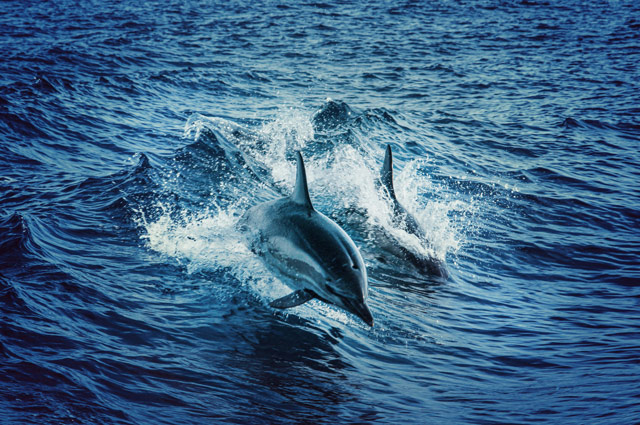
Dolphins are a captivating part of the diverse Maui marine life, bringing joy and wonder to those who encounter them. Their intelligence and playful antics are a highlight of any ocean adventure. In Maui, several dolphin species grace the waters, each contributing to the rich tapestry of Maui marine life. Here are three that you may see:
- Spinner Dolphins: These agile dolphins are renowned for their incredible aerial displays. They spin vertically along their body axis as they leap from the water, often completing multiple rotations. These spins are thought to be a form of communication, play, or even parasite removal. Spinner dolphins are social animals, often forming large pods that can number in the hundreds. They are primarily nocturnal feeders, venturing into deeper waters to hunt for small fish, squid, and shrimp. During the day, they often rest in shallower, sheltered bays. As a consistent part of Maui marine life, they are year-round residents.
- Bottlenose Dolphins: Known for their robust build and high intelligence, bottlenose dolphins are frequently seen in Maui’s coastal waters. They are highly adaptable and can be found in a variety of habitats, from shallow bays to deeper offshore areas. Bottlenose dolphins are social animals, forming complex social structures and engaging in cooperative hunting. Their diet consists of a wide range of prey, including fish, squid, and crustaceans. These dolphins are also year-round residents, solidifying their place in the ongoing displays of Maui marine life.
- Rough-toothed Dolphins: While less frequently encountered, rough-toothed dolphins add to the diversity of Maui’s dolphin population. They prefer deeper, offshore waters and are characterized by their slender bodies and long, pointed snouts. Their diet primarily consists of fish and squid. These dolphins are less social than spinners or bottlenose and are often seen in smaller groups.
Fun Fact!
Spinner dolphins, like many other dolphins, use signature whistles. These whistles act like individual “names” that help them identify and communicate with each other within their pods. It’s like they have their own underwater language!
What Attracts Dolphins to Maui?
Maui’s warm, clear waters, abundant food sources, and diverse marine ecosystem create an ideal habitat for dolphins. The sheltered bays and coastlines provide safe havens, and the warm temperatures allow them to thrive year-round.
Sea Turtles:
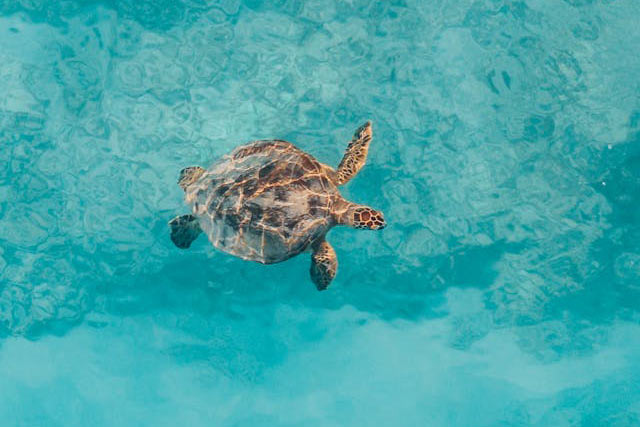
The Hawaiian green sea turtle, or “honu,” is a beloved symbol of Maui marine life and environment. These beautiful and gentle creatures are a common sight in the island’s waters. They bring a sense of tranquility to the vibrant Maui marine life.
Life Cycle and Nesting
Hawaiian green sea turtles primarily nest on the beaches of the Northwestern Hawaiian Islands, but some nesting does occur on Maui. Nesting typically happens during the summer months, from April to September. Female turtles come ashore at night to dig nests in the sand and lay their eggs. After laying her eggs, the female turtle returns to the sea. The eggs incubate for approximately 60 days, depending on sand temperature. Hatchlings emerge from the nest at night and instinctively crawl towards the ocean, guided by the moonlight. Sadly, many hatchlings do not survive to adulthood.
Diet and Feeding Habits
Adult Hawaiian green sea turtles are primarily herbivores, feeding on algae and seagrass. Juvenile turtles, however, are omnivorous, consuming small invertebrates, such as crustaceans and jellyfish, in addition to algae. They are often seen grazing on the algae that grow on the lava rocks near the shore.
Why Maui is a Turtle Paradise
Maui’s warm, shallow waters provide an ideal habitat for green sea turtles. The abundance of algae and seagrass along the island’s coastlines offers a plentiful food source. The sheltered bays and reefs provide safe havens for turtles to rest and forage. The warm water temperatures that remain fairly consistent year-round allow the turtles to thrive.
Fun Fact!
Hawaiian green sea turtles often bask in the sun on beaches, but they don’t need sunscreen! Their dark shells help absorb warmth, and their skin is naturally protected.
Encountering Turtles in Maui
Hawaiian green sea turtles are a relatively common sight in Maui’s waters, especially in shallow, coastal areas. They are often seen swimming near reefs, basking on beaches, or foraging for food. Popular spots for turtle sightings include Maluaka Beach (Turtle Town), and various reefs along the south and west shores of Maui. While they are common, it is important to remember that they are protected, and it is illegal to harass or disturb them. Observe them from a respectful distance, and never touch or feed them. They are a very important part of the Maui marine life. Seeing a turtle is a very common part of enjoying the amazing animals that make up Maui’s wildlife.
Tropical Fish: A Living Rainbow Under the Sea
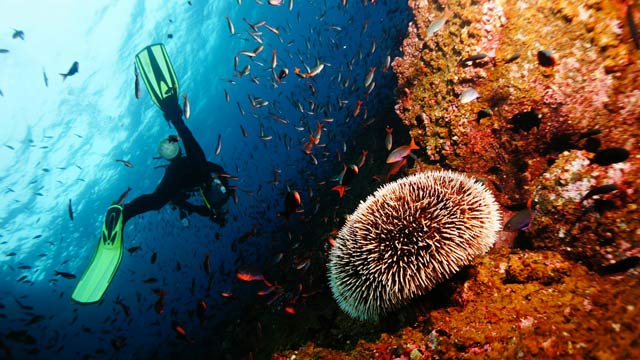
The reefs surrounding Maui are a kaleidoscope of color, thanks to the incredible variety of tropical fish that call these waters home. While whale watching is a highlight, exploring the underwater world reveals another layer of Maui marine life.
A Diverse Underwater Community
You’ll find a dazzling array of species, including butterflyfish with their intricate patterns, parrotfish with their vibrant hues and powerful beaks, and angelfish gliding gracefully through coral formations. Other common sights include tangs, wrasses, and triggerfish, each contributing to the reef’s vibrant ecosystem.
Ideal Habitats in Maui’s Waters
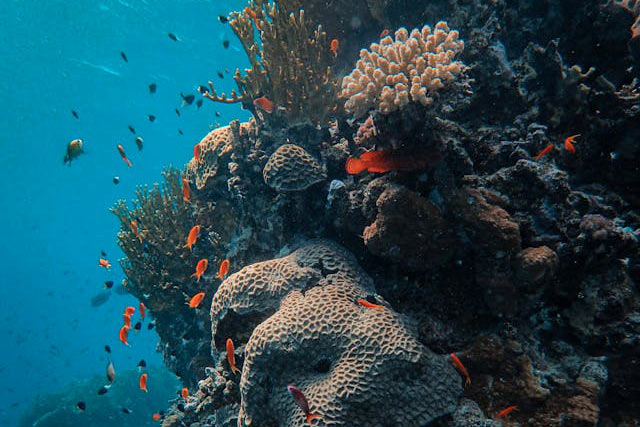
Tropical fish thrive in shallow, warm waters with abundant coral reefs. They prefer areas with plenty of hiding places, such as crevices, caves, and branching corals. The reefs along Maui’s south and west shores offer ideal habitats, with clear water and diverse coral structures. Maui’s warm, consistent water temperatures create a comfortable environment for tropical fish. The island’s diverse reef systems provide a wide range of food sources and shelter. The clear water allows sunlight to penetrate, promoting the growth of algae, which many fish rely on for food.
Tropical Fish Diet and the Reef’s Food Chain
Tropical fish have diverse diets, depending on their species. Many are herbivores, grazing on algae that grow on coral and rocks. Others are carnivores, feeding on small invertebrates, crustaceans, and other fish. Parrotfish, for example, use their strong beaks to scrape algae off coral, while butterflyfish use their long snouts to probe for invertebrates in crevices. Tropical fish are an important part of the reef’s food chain. Larger predatory fish, such as jacks and barracudas, prey on smaller tropical fish. Sharks also play a role in regulating fish populations. Also, eels will eat many smaller fish. Even some of the larger tropical fish will eat the smaller ones.
Fun Fact!
Parrotfish play a crucial role in creating the beautiful sandy beaches of Maui. They eat algae off coral, and their beaks grind the coral into fine sand. One parrotfish can produce hundreds of pounds of sand each year!
Manta Rays: The Underwater Flyers of Maui Marine Life
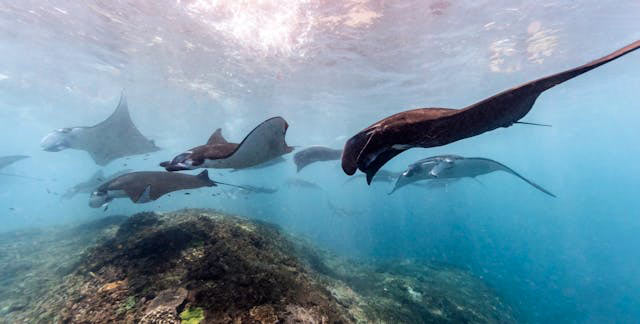
If you’re incredibly fortunate, you might encounter the majestic manta ray during your time in Maui’s waters. These gentle giants, often likened to underwater birds, are a truly awe-inspiring sight and a rare treat within Maui marine life.
Manta rays are known for their impressive size, with wingspans that can reach up to 29 feet, though most commonly they are seen with wingspans of around 12 to 15 feet. Their large, flat bodies and wing-like pectoral fins allow them to glide effortlessly through the water, creating a sense of grace and tranquility.
Encounters with Maui’s Manta Rays
Manta rays are filter feeders, meaning they consume plankton and small crustaceans by filtering them out of the water. They swim with their mouths wide open, allowing water to flow through their gill rakers, which trap the tiny organisms. They are often seen feeding near the surface, especially at night, when plankton concentrations are higher. While manta rays are found in tropical and subtropical waters worldwide, they are not as commonly sighted as dolphins or sea turtles in Maui.
Sightings are considered a special treat, and they are not guaranteed on every trip, thus making them a unique part of Maui marine life. However, when they are spotted, the experience is unforgettable. They are more likely to be seen along the west and south coasts of Maui, where water conditions and food sources are favorable. It is always important to observe them from a distance and avoid disturbing their natural behavior.
Fun Fact!
Manta rays have the largest brain-to-body size ratio of any fish. This suggests they are highly intelligent creatures. They have been observed displaying complex social behaviors and problem-solving skills.
Flying Fish: The Gliders of the Sea

The sight of flying fish skimming across the water’s surface is a delightful surprise, adding a touch of magic to the ocean experience. These unique fish, a fascinating component of Maui marine life, possess the remarkable ability to launch themselves into the air and glide for considerable distances. Flying fish are most often found in warm, tropical, and subtropical waters, including the areas surrounding Maui. They tend to prefer open ocean environments, away from the immediate shoreline, which is why they are often seen during boat trips.
Diet, Habitat, and Predators
Flying fish are omnivorous, with their diet consisting primarily of plankton, small crustaceans, and algae. They feed near the surface of the water, using their small mouths to scoop up their prey. The fish are an important part of the marine food chain and are preyed upon by a variety of larger marine animals, including predatory fish like tuna, marlin, and swordfish, as well as seabirds and dolphins. These predators are a natural control on the flying fish population within the vast ecosystem of Maui marine life.
Fun Fact!
Flying fish don’t actually “fly” like birds. They glide! They use their powerful tails to propel themselves out of the water, and then spread their enlarged pectoral fins to catch the air. They can stay airborne for hundreds of feet, and even change direction slightly.
The Flying Fish Life Cycle
The life cycle of a flying fish begins with eggs that are laid in the open ocean, often attached to floating objects like seaweed or debris. Once hatched, the larvae drift with the currents, feeding on plankton. As they grow, they develop their characteristic enlarged pectoral fins, which allow them to glide through the air. Flying fish use their powerful tails to propel themselves out of the water, and once airborne, they spread their fins to glide, sometimes covering distances of hundreds of feet. Their ability to take flight is primarily a defense mechanism, allowing them to escape predators. They are a very unique part of the Maui marine life.
Understanding the Ecology of Maui Marine Life
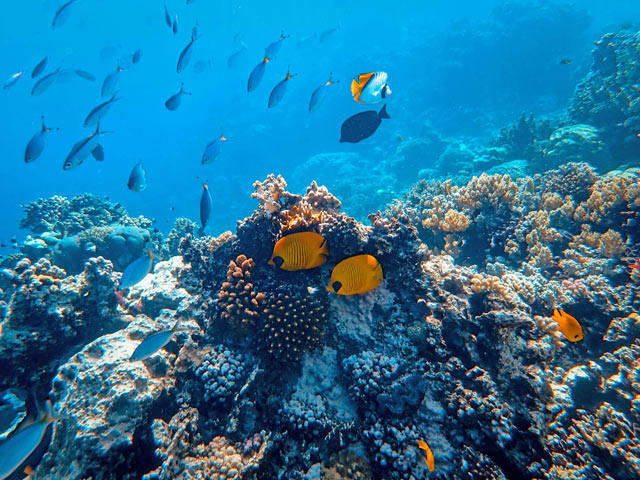
The breathtaking beauty of Maui’s waters is more than just a scenic backdrop; it’s a complex and interconnected ecosystem that supports a rich diversity of life. Understanding the ecology of Maui marine life is crucial for preserving its health and ensuring its longevity. The delicate balance of this ecosystem is influenced by a multitude of factors, including water temperature, nutrient levels, and the interactions between various species. Every creature, from the smallest plankton to the largest whale, plays a role in maintaining this balance.
The Interconnected Web of Life
Ecology is the study of how organisms interact with each other and their environment. In Maui, this means understanding the relationships between the coral reefs, the fish that inhabit them, the dolphins that patrol the coastlines, and the whales that visit seasonally.
The health of the coral reefs, for instance, directly impacts the abundance and diversity of fish populations. Healthy reefs provide shelter and food for countless species, while degraded reefs can lead to declines in fish populations and overall ecosystem health. The importance of keeping the reefs healthy is a key part of maintaining the rich Maui marine life. The actions of humans, such as pollution and overfishing, can have far-reaching consequences for the entire ecosystem. That’s why conservation efforts are so important.
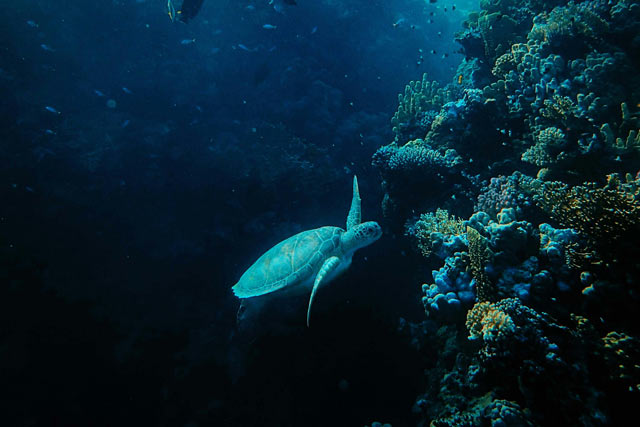
Organizations Dedicated to Mau Marine Life Conservation
Several organizations are dedicated to protecting and preserving Maui’s marine environment, all with dedicated volunteers actively working on conservation. One group is called the Maui Ocean Center Marine Institute (MOCMI). MOCMI is dedicated to the rescue, rehabilitation, and release of Hawaiian sea turtles. They also conduct research and education programs focused on Maui marine life conservation.
Conservation organizations in Maui often work together on things like beach cleanups, reef monitoring, and educational programs. Their efforts contribute to the health of all Maui marine life. Many local groups work to educate residents and visitors alike on the importance of responsible ocean practices. It is important to look for tours that mention that they follow responsible guidelines regarding marine life.
Responsible Ocean Practices
As visitors and residents of Maui, we all have a responsibility to protect its marine environment. This includes practicing responsible ocean activities, such as avoiding touching or disturbing marine animals, properly disposing of trash, and using reef-safe sunscreen.
Supporting local conservation efforts and educating ourselves about the importance of marine ecology are also essential steps in preserving the beauty and health of Maui’s waters. When taking a whale watching tour, or any ocean-related tour, it is important to choose a tour operator that respects the animals.
Conclusion
While the majestic humpback whales draw visitors from around the globe, it’s clear that Maui’s ocean offers a wealth of experiences beyond these seasonal giants. The vibrant tapestry of Maui marine life, from playful dolphins and graceful sea turtles to the dazzling array of tropical fish and the occasional glimpse of a manta ray, creates an underwater world that’s both captivating and essential.
By understanding the interconnectedness of the Maui marine ecosystem and practicing responsible ocean habits, we can ensure that the beauty and diversity of Maui marine life remain for future generations to cherish. So, whether you’re embarking on a whale watching tour or simply exploring the shoreline, take a moment to appreciate the incredible richness of the Maui marine life.



